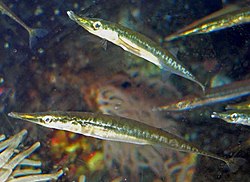![]() There are millions of sticklebacks across the globe, but you can also find sticklebacks in fossil form. The scientific name for most fossil sticklebacks is Gasterosteus doryssus, but morphologically this fossil “species” belongs within the threespine stickleback complex.
There are millions of sticklebacks across the globe, but you can also find sticklebacks in fossil form. The scientific name for most fossil sticklebacks is Gasterosteus doryssus, but morphologically this fossil “species” belongs within the threespine stickleback complex.
One Miocene fossil site has offered up some fascinating insights into the pace of evolution in threespine stickleback. Today I’ll be focusing on a paper that examines evolution in diet type in this unique stickleback “population”.
A few weeks ago, I mentioned “limnetic” and “benthic” stickleback – two different morphs of freshwater stickleback that live in different places within a lake and eat different things. Limnetic stickleback generally swim in the open areas of the lake and feed on zooplankton like calanoid copepods. Benthic stickleback stay close to the lakebed and feed on insect larva and small crustaceans like gammarids and ostracods.
In an earlier paper, it was shown that you can identify whether a stickleback is benthic or limnetic just from tiny scratches on the teeth. That technique was applied to fossil sticklebacks, with some striking results: at different periods in time, the population changed from limnetic to benthic and back again to limnetic.
Most stickleback in this lake were limnetic, which makes a lot of sense – in order for the stickleback to be preserved in anoxic sediment, the lake had to be fairly deep, which opens up a lot of potential habitat for limnetic stickleback. In addition, the substrate the sticklebacks are buried in is called diatomaceous earth – basically, millions and millions of dead diatoms, a type of phytoplankton. Lots of phytoplankton swimming around suggests there was zooplankton that ate them, which would provide a perfect source of food for limnetic stickleback.
Fossil sticklebacks (photo courtesy of Michael Bell)
So what about the point in time where the population changed from limnetic to benthic? The authors suggest that because of the speed of the change – and because there are few sticklebacks from these rocks that are halfway between benthic and limnetic – it might be the case that the limnetic sticklebacks went extinct and were replaced by a new population of invading benthic stickleback.
Still, even if we can’t say for sure whether the limnetics were replaced by benthics or whether they evolved into benthics, we can say that the benthic population evolved into a limnetic population over a few thousand years, because the pattern of tooth wear changes from the heavy markings typical of a benthic to the lighter markings typical of a limnetic.
It’s rare that we can use fossils to examine how a specific population changes over time, but because we can take our understanding of modern stickleback and apply it to the fossils, we can learn a lot about the dynamics of evolutionary change.
Purnell, M., Bell, M., Baines, D., Hart, P., & Travis, M. (2007). Correlated Evolution and Dietary Change in Fossil Stickleback Science, 317 (5846), 1887-1887 DOI: 10.1126/science.1147337







